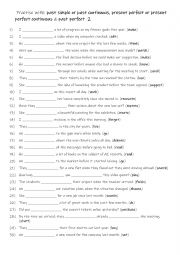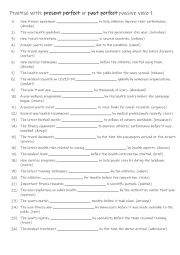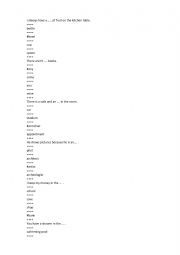
EXPRESSIONS WITH NAMES OF COUNTRIES OR NATIONALITIES 3
There are 18 expressions with names of either countries or nationalities with meanings. They read these and do a gap fill activity to test their understanding of the same. In this one the gap fill activity is considerably larger than in the previous two. Objective is vocabulary enhancement. Hope you can use it. :)
Level: intermediate
Age: 10-100
Type:

Age or ......
Students are asked to deal with the new staff. There should be a good selection of activities. There should also a neter selection for the sake of getting bettter results.
Level: advanced
Age: 16-100
Type:

Present Perfect Simple or Present Perfect Continuous
A 6-page worksheet to practise or review the present perfect simple and present perfect continuous. Answer KEY included.
Level: intermediate
Age: 11-100
Type:

Past Simple or Past Continuous
Seven exercises to practise or review the Past Simple and Past Continuous. With answer KEY.
Level: intermediate
Age: 10-100
Type:

A2+-B1 Practise with past simple or past continuous, present perfect or present perfect continuous & past perfect 1
Students should practise past simple, past continuous, present perfect, present perfect continuous, and past perfect to communicate more precisely about different timeframes, actions, and experiences. These tenses help in narrating events, linking the past with the present, and describing ongoing actions. They improve fluency, enable clearer conver...
Level: intermediate
Age: 8-100
Type:

B1-B2 Active or passive voice using: present simple passive, past simple passive, future simple passive, present continuous active, past continuous active, past continuous passive, present perfect passive, past perfect passive, future perfect passive, fut
Learning active and passive voice across these tenses enhances students� ability to express ideas flexibly and appropriately. Passive voice focuses on the action or result, especially when the doer is unknown, unimportant, or implied, making it essential for formal contexts like academic writing, journalism, or reports. Active voice, on the other...
Level: intermediate
Age: 10-100
Type:

A2+-B1 Gerund or infinitive practise 2
Learning the difference between gerunds and infinitives is essential for achieving accuracy and fluency in English. Gerunds (verbs ending in -ing, like "swimming") and infinitives (the base form with "to," like "to swim") often have specific rules or conventions that dictate their use, which can change the meaning of a sentence. For example, "I sto...
Level: intermediate
Age: 9-100
Type:

Media vocabulary list
a list of vocabulary relate to Media
Level: intermediate
Age: 14-17
Type:

B1-B2 Practise with present simple and past simple passive or active voice 1
Students should learn Present Simple and Past Simple in both Active and Passive voices because these tenses are essential for effective communication. The Active voice allows students to describe routines, habits, and completed actions clearly, while the Passive voice helps shift focus to the action or the object, which is important for various sit...
Level: intermediate
Age: 10-100
Type:

A2+-B1 Practise with past simple or past continuous, present perfect or present perfect continuous & past perfect 2
Students should practise past simple, past continuous, present perfect, present perfect continuous, and past perfect to communicate more precisely about different timeframes, actions, and experiences. These tenses help in narrating events, linking the past with the present, and describing ongoing actions. They improve fluency, enable clearer conver...
Level: intermediate
Age: 9-100
Type:

A1-A2 Practise with present simple or present continuous 1
Students should practice the present simple and present continuous tenses because they help distinguish between routines or facts (present simple) and ongoing or temporary actions (present continuous). Mastery of these tenses boosts confidence in daily conversations, ensures clarity in expressing different types of actions, and forms a foundation f...
Level: elementary
Age: 8-100
Type:

A2+-B1 Practise with present perfect or present perfect continuous 1
Students should practice the present perfect and present perfect continuous tenses because they help express actions or experiences connected to the present. The present perfect describes past actions with current relevance (e.g., "I have visited Paris"), while the present perfect continuous emphasises ongoing actions or their duration (e.g., "I ha...
Level: intermediate
Age: 10-100
Type:

B1-B2 Practise with present perfect or past perfect passive voice 1
Students should learn to practise the present perfect and past perfect passive voice because these structures are vital for expressing completed actions with emphasis on the results rather than the doer. The present perfect passive (e.g., "The work has been finished") is used to discuss actions that affect the present, while the past perfect passiv...
Level: intermediate
Age: 10-100
Type:

Beginner vocabulary list
This is for first year students to learn vocabulary from Beginner level
Level: elementary
Age: 15-100
Type:

End of term test
End of term test suitable for intermediate level
Level: intermediate
Age: 16-17
Type:
|
|
|